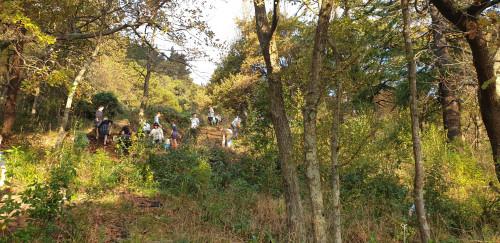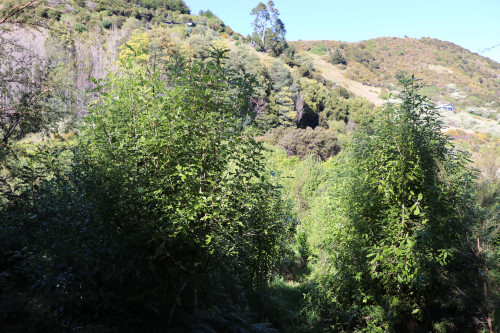Soil Erosion
Soil erosion occurs naturally, usually triggered by a combination of heavy rainfall, unstable geology and loss of vegetation. Erosion can be accelerated by our land-use activities. These include vegetation clearance, intensive stocking and cropping, building roads and other activities that expose the soil.
Erosion has a number of potentially negative impacts.
- On hillslopes, slips remove topsoil and often a large amount of subsoil leaving a very poor surface for vegetation growth.
- Gradual loss of topsoil (which can occur where vegetation cover is poor) affects the soil quality, reducing the fertility and productive capacity of the soil resource.
- Along streams and rivers, streambank erosion directly deposits sediment into the water and can damage riparian fencing.
- Soil loss and resulting sedimentation degrade water quality in adjacent or downstream water bodies.
- Downstream deposition of eroded soil causes rivers to become filled in with silts and gravel which can increase the risk of flooding and damage to farm infrastructure and housing.
- Some types of erosion can affect land stability for housing and other uses.
Soil erosion in Nelson City region
The main types of erosion in the Nelson City region are soil slips, surface erosion (mainly on hillslopes), streambank erosion and land use related soil disturbance.
Soil slips/surface erosion
Soil slips (sometimes called shallow landslides or earthflows) are the most common form of mass movement erosion. They are typically characterised by small slip scars and long narrow debris tails with most of the soil redeposited downslope, sometimes reaching waterways. They occur most commonly during rainfall events, especially during high-intensity-rainfall, or during small rainfall events after prolonged wet periods.
Surface erosion occurs on bare ground where the soil has been exposed or there is little vegetation to protect the soil. This can include the surface of existing landslides and gullies, as well as heavily grazed pastures or pastures affected by drought. Factors that influence surface erosion include slope angle, length and aspect, soil texture, soil compaction, and rainfall, especially intensity and duration.
Streambank erosion
Streambank erosion occurs on the banks of streams and rivers, especially on outside bends, where the river or stream is incised, or where the banks are made up of finer sediments such as sand, silt and clay.
Fencing stock out of streambanks and planting riparian vegetation will increase streambank stability. Streambank erosion is lessened during storms if woody vegetation in upper catchments in retained or increased.
Land-use related disturbance
Land use associated soil disturbance or lack of vegetation protection can increase the potential for surface erosion and soil loss.
Surface erosion potential is increased:
- on unmanaged farm and forest tracks;
- where livestock grazing pressure exposes bare soil;
- on areas that are cultivated (for cropping) and harvested (including forest harvesting); and
- where there are earthworks.
These areas need to be managed carefully to minimise erosion and loss of soil offsite and into waterways.
A national assessment or erosion prone land suggested that in 2007 the land area at risk of erosion in the Nelson City region was between 1500-1600 hectares.
Although there are no specific erosion monitoring data, the steeper areas of land most prone to erosion are mostly under indigenous forest or plantation forest vegetation cover. This woody vegetation increases the protection of the soil from erosion.
A recent survey of streams running through pastoral land within the region showed that out of the 103 km of stream banks for waterways under pasture, stock have access to about 42 km. These unprotected stream banks could be vulnerable to instability and erosion.
Assessing land for erosion - Land Use Capability classification
The Land Use Capability (LUC) classification is a useful tool for identifying areas with potential for erosion, to help match land capability with land use and implement soil conservation work.
The Land Use Capability (LUC) classification uses the New Zealand Land Resource Inventory (NZLRI) as a basis for arranging different kinds of land according to its capacity to support long-term sustained production, after considering the physical limitations of the land. The classification was first devised in 1969 with minor subsequent revisions in 1971 and 2009.
There are three components to the LUC classification:
Land use capability class
The LUC Class is the broadest grouping of the classification giving a broad assessment of the land’s capability and versatility for use by different types of agricultural production given its physical limitations.
Land use Capability Subclass
The LUC subclass denotes the main physical limitation for a piece of land. Four limitations are recognised:
‘e’: erodibility (e.g. mass movement, gully/rill, wind)
‘w’: wetness (e.g. high water table, slow drainage, flooding)
‘s’: soil (e.g. shallow soil, stoniness, water holding capacity)
‘c’: climate (e.g. dry, wet, frost/snow)
Land use capability unit
The LUC unit is the most detailed level of classification. It allows for subclasses to be further classified based on the kind and intensity of management or conservation treatment required.
The LUC units are ordered in decreasing versatility/increasing degree of limitation. For example, ‘6e5’ is less versatile and requires more intensive conservation than ‘6e1’).
Using the LUC on your property
A property scale assessment of LUC can help you make soil conservation and land management decisions to minimise the chance of erosion on your property. The best mapping scale for your property will depend on the size of your property and its land use. The following guide can assist you with the best scale for mapping LUC on your property.
Reducing erosion
Common ways to reduce erosion include:
- maintaining good vegetation cover on hillslopes;
- planting trees on hills and stream banks;
- fencing gullies and waterways to prevent stock access;
- removing pest animals;
- keeping stock off wet soils;
- planting cover crops when land is left fallow;
- avoid cultivating steep land;
- implementing soil conservation planting on erosion prone hillslopes;
- retiring unproductive land, especially in upper catchments;
- retiring and protecting natural wetlands and seeps; and
- using appropriate practices for earthworks;
What are we doing to reduce soil erosion?
Hill Country Erosion Fund
Nelson City Council has funding from the Ministry for Primary Industries Hill Country Erosion Fund to work with landowners on land management for lifestyle blocks and farms in the Wakapuaka area. For more information click here.

National Environmental Standard for Plantation Forestry (NESPF)
The National Environmental Standard for Plantation Forestry (NESPF) came into force on 1 May 2018. It defines a range of forestry activities which are "permitted". The NESPF regulations apply for any plantation forest which:
- Is at least one hectare, and
- Has been planted specifically for commercial purposes, and
- Will be harvested.
The eight activities referred to in the regulations are:
- Afforestation (planting new forest).
- Pruning and thinning-to-waste (selective felling of trees where the felled trees remain on site).
- River crossings.
- Forestry quarrying (extraction of rock, sand, or gravel within a plantation forest or for operation of a forest on adjacent land).
- Mechanical land preparation.
If you are undertaking one of these activities you may not require a Resource Consent, as the activity may be permitted under the NESPF rules. Instead of a consent, some of the permitted activity rules require you to provide written notice to Council, and some of them require a management plan.
To determine what you need to provide, please consult the regulations. More information is available at National Environmental Standards on Plantation Forestry. The areas where you are likely to require a resource consent are shown by the Erosion Susceptibility Classification.
About the Erosion Susceptibility Classification
The Erosion Susceptibility Classification is a tool developed for the NES-PF to assess the environmental risk for plantation forestry activities, reducing the potential for erosion.
The tool divides the New Zealand landscape into four erosion categories according to risk:
- Green (low) and yellow (moderate)— land less likely to erode. Plantation forestry activities are permitted.
- Orange (high risk) or red (very high risk)— land more likely to erode. Most forestry activities in the red zone will require resource consent. Some activities, such as earthworks require consent on orange-zoned land with steeper slopes.
Will climate change affect soil erosion?
The effects of climate change will likely increase the frequency and intensity of the existing pressures contributing to erosion; more frequent droughts and a greater frequency and intensity of storms. Reduced vegetation cover following droughts will increase the risk of erosion if there is a storm. Also, greater flood flows will increase the potential for streambank erosion.

